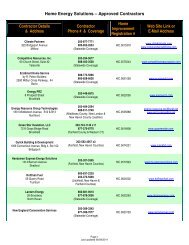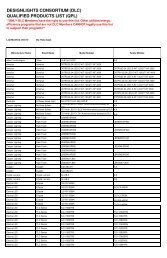here - Northeast Utilities
here - Northeast Utilities
here - Northeast Utilities
Create successful ePaper yourself
Turn your PDF publications into a flip-book with our unique Google optimized e-Paper software.
RESULTS OF CL&P PLAN-IT WISE ENERGY PILOT<br />
Docket No. 05-10-03RE01<br />
Compliance<br />
Order No. 4<br />
Customers<br />
Residential<br />
(Rate 1 & 5)<br />
C&I<br />
(Rate 30 & 35)<br />
Period<br />
Peak Load<br />
Reduction<br />
Monthly<br />
consumption<br />
change<br />
Peak Load<br />
Reduction<br />
Monthly<br />
consumption<br />
change<br />
TOU PTR CPP<br />
High<br />
With<br />
High<br />
With<br />
High<br />
With<br />
Diff.<br />
Tech<br />
Diff.<br />
Tech<br />
Diff.<br />
Tech<br />
-3.1%<br />
-10.9%<br />
-17.8%<br />
-16.1%<br />
-23.3%<br />
-0.1%<br />
-0.2%<br />
+0.2%<br />
0%<br />
0%<br />
-4.1%<br />
-2.8%<br />
-7.2%<br />
0%<br />
0%<br />
0%<br />
For the Residential class, CPP had the greatest impact, with customers shifting peak demand by 16.1<br />
percent. The presence of an “enabling” technology increased the impact to 23.3 percent. PTR showed<br />
the second highest impact, with customers shifting peak demand by 10.9 percent, and 17.8 percent with<br />
“enabling” technology. TOU customers shifted peak demand by 3.1 percent, with or without “enabling”<br />
technology. Monthly energy conservation results, although statistically significant, were very small,<br />
ranging from -0.2 percent for PTR rates to +0.2 percent for CPP rates (representing a slight increase in<br />
overall monthly consumption).<br />
For the C&I class, similar results occurred, although the impact was less pronounced than that of<br />
Residential customers, which is consistent with evidence from other Pilots across the country. As it<br />
relates to the CPP program, a statistically measurable peak load shift was achieved either with (reduction<br />
of 7.2 percent) or without “enabling” technology (reduction of 2.8 percent). However, for the PTR, a<br />
peak load response was only achieved with the existence of enabling technology (4.1 percent). Absent<br />
“enabling” technology, the PTR program for the C&I class yielded no peak load response benefits.<br />
No statistically measurable response was found for TOU C&I customers with or without “enabling”<br />
technology. That is, during on-peak periods, Pilot customers indicated no difference in their peak load and<br />
energy consumption patterns with the existence of TOU pricing compared to the control group customers.<br />
These results were not surprising as C&I customers expressed concern about their ability to respond to the<br />
lengthy eight-hour TOU period during CL&P’s focus group sessions that were held prior to the Pilot<br />
implementation. This is also understandable given the fact that the C&I group that was tested generally<br />
does not include the larger businesses that are most likely to have sophisticated energy management<br />
systems or the ability to dramatically modify consumption patterns. The 100 kW and below C&I<br />
customers are largely retail businesses and office buildings that may either be operated by someone other<br />
than the owner and thus less sensitive to energy cost issues, or businesses in which load response to the<br />
long eight hour on-peak window during each weekday is simply not achievable due to business<br />
operations.<br />
Other key findings from the Pilot analysis include:<br />
• Residential and small C&I customers responded to dynamic rates in spite of relatively mild<br />
summer conditions (a further description of how weather was modeled is presented in Appendix<br />
A, pages 29 to 32; as well as Appendix B, pages 6 & 7).<br />
• Residential customer demand response impacts compare favorably to those of other Pilots (a<br />
comparison to other known residential Pilots is presented in Appendix A, page 15).<br />
Page 8 of 11










